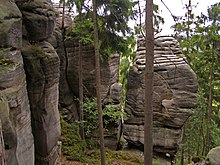Žďár nad Metují
| Žďár nad Metují | ||||
|---|---|---|---|---|
|
||||
| Basic data | ||||
| State : |
|
|||
| Region : | Královéhradecký kraj | |||
| District : | After that | |||
| Area : | 817 ha | |||
| Geographic location : | 50 ° 33 ' N , 16 ° 12' E | |||
| Height: | 441 m nm | |||
| Residents : | 665 (Jan. 1, 2019) | |||
| Postal code : | 549 55, 552 05 | |||
| structure | ||||
| Status: | local community | |||
| Districts: | 1 | |||
| administration | ||||
| Mayor : | Pavel Šubíř (as of 2007) | |||
| Address: | Žďár nad Metují 146 549 55 Žďár nad Metují |
|||
| Municipality number: | 574686 | |||
| Website : | www.zdarnadmetuji.cz | |||
Žďár nad Metují (German Brand an der Mettau ) is a municipality with 559 inhabitants in the Czech Republic . It is located at the foot of the Ostaš mountain (700 m) at 441 m above sea level. M. one kilometer west of the town Police nad Metují and belongs to the Okres Náchod .
geography
The place at the brook Dunajka is located on a plateau surrounded by the Metuje ( Mettau ) from west to south. The Ostaš rises to the north. To the south at the mouth of the Dunajka and the Mettau, the Vlčinec castle is said to have stood in the past , of which only a few remains of the wall have survived.
Neighboring places are in the west Česká Metuje , in the southwest Maršov nad Metují, in the east Police nad Metují and in the northeast Bukovice . The railway from Náchod to Meziměstí passes southwest , where Žďár has a train station. A seasonal campsite is located on the Dunajka above the village.
history
The history of the place is closely linked to that of Police nad Metují , the settlement of the area by the Benedictines and the Braunau monastery . In 1294, Abbot Bavor laid down the land boundaries that still exist today. From the confluence of the stream into the Mettau, the construction of a tunnel in the direction of Police was started. In the first half of the 15th century, the Vlčinec Castle is said to have been built there on the steep abyss. During the Hussite Wars , Catholics sought refuge in the rocks of the Ostaš. In 1484 the wooden cross chapel was built on the mountain.
During the Thirty Years' War the place was visited alternately by the imperial and the Protestant in 1621, later the Swedes invaded, from whom the inhabitants again sought protection on the Ostaš. During the peasant uprisings of 1680, cuirassier regiments under Otto de Grana moved into Žďár on April 7, 1680 and stayed there for the night. Between 1711 and 1720, at the instigation of the Braunau abbot Othmar Daniel Zinke, a Romanesque church was built on the Ostaš instead of the ruined chapel. However, this was demolished in 1788 together with the parish church on the Politzer cemetery on the order of Emperor Joseph II and the stones were used to build houses.
In 1875 the railway from Chotzen to Braunau was inaugurated , but it was not until 1922 that the railway kept on fire. The new train station with a waiting hall was called "Maršov" in the first few years.
Web links
Individual evidence
- ↑ Český statistický úřad - The population of the Czech municipalities as of January 1, 2019 (PDF; 7.4 MiB)


